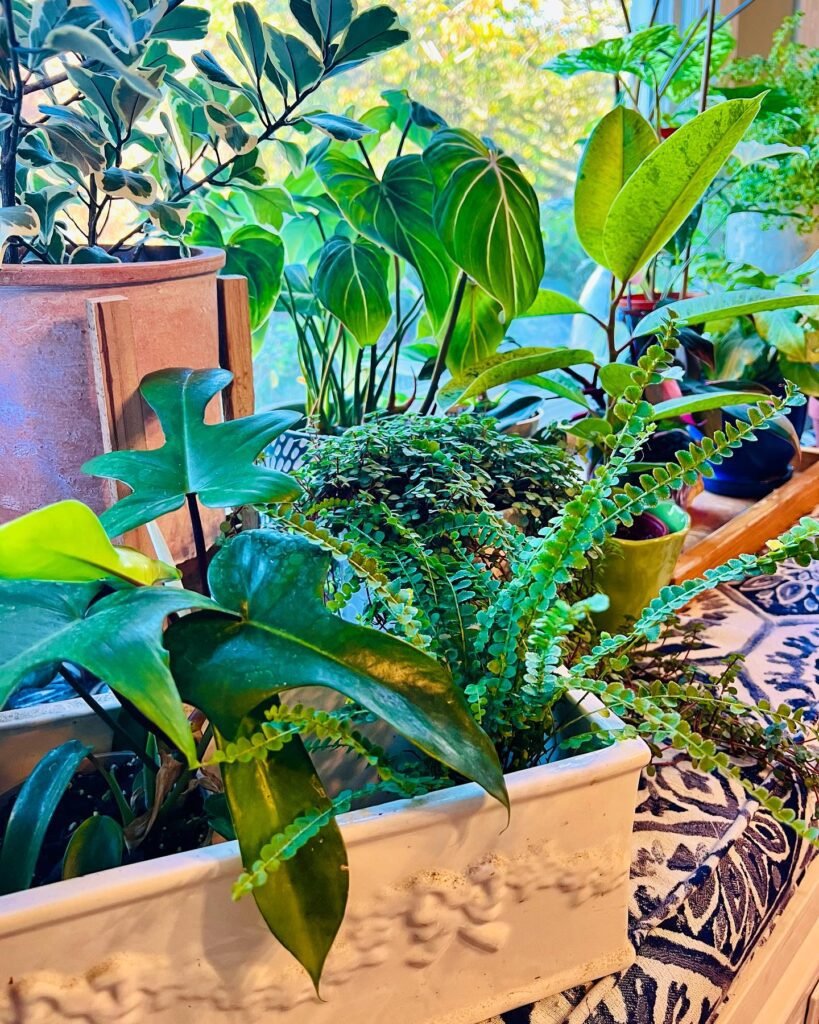Did you know that indoor plants are becoming increasingly popular in the UK? More and more people are discovering the joy of bringing nature into their homes, and one plant that is capturing the hearts of plant enthusiasts is the Pellaea rotundifolia, also known as the Button Fern. With its unique appearance and easy-care nature, this fern variety is an ideal choice for any indoor plant lover.
In this article, I will guide you through the essential care tips for Pellaea rotundifolia, helping you create a thriving and beautiful indoor garden. Whether you’re a beginner or a seasoned indoor plant enthusiast, you’ll find valuable information on light requirements, watering tips, fertilization, pruning, propagation, repotting, and the fern’s toxicity. So, let’s dive in and discover how to care for your own Button Fern in the UK.
Appearance of Pellaea rotundifolia
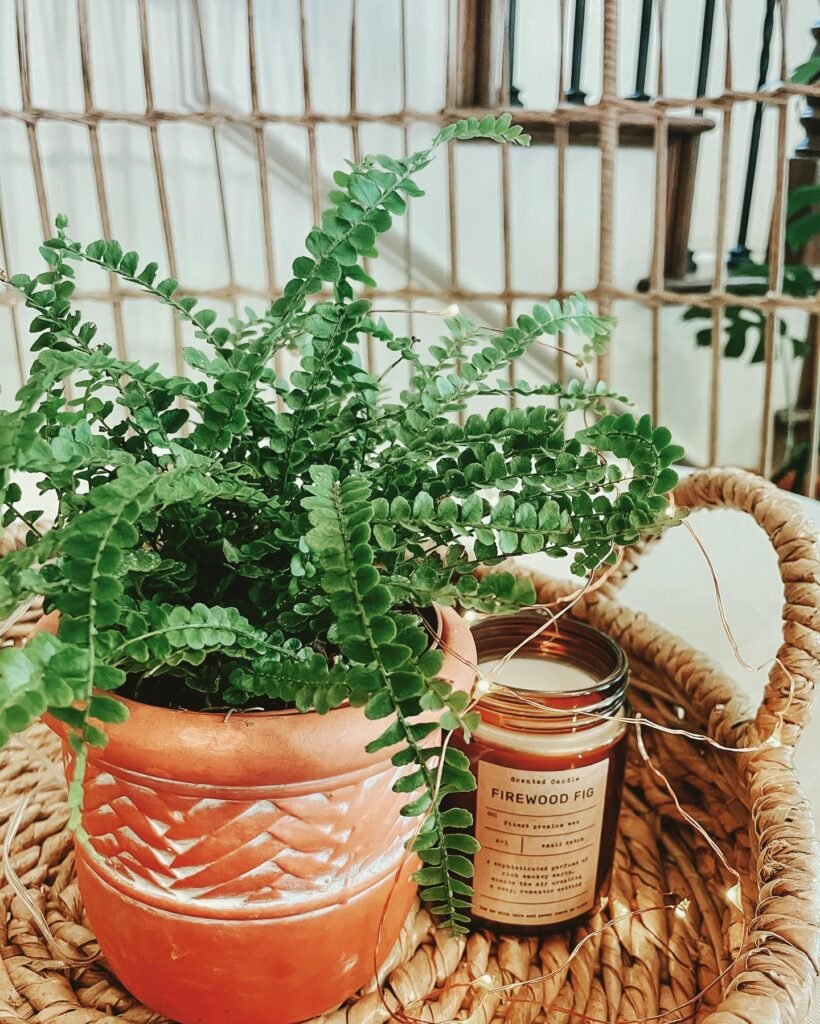
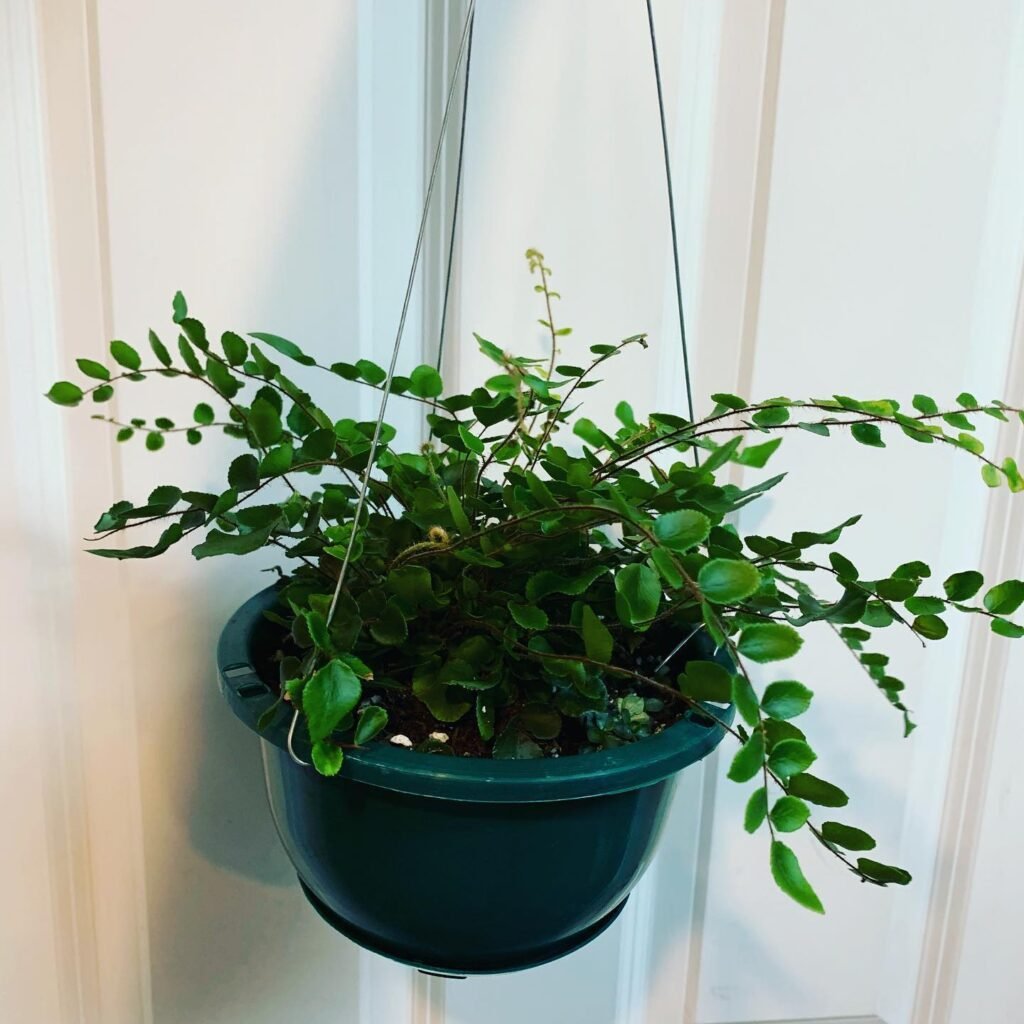
The Pellaea rotundifolia, commonly known as the Button Fern, is a captivating addition to any indoor plant collection, celebrated for its distinctive and charming appearance. Characterised by a bushy form, this fern elegantly displays an almost flat rosette composed of pinnate fronds, each frond stretching out to about 25cm in length. These fronds are adorned with rounded, deep green leaflets, presenting a lush and textured look that’s both delicate and robust.
A striking feature of the Button Fern is its fronds, which gracefully perch atop dark brown stems. These stems are uniquely highlighted with pink scales, adding a subtle contrast and depth to the plant’s overall look. This intriguing blend of colours and textures contributes significantly to the Button Fern’s allure, making it a standout piece in any indoor garden.
Compact in size, the Button Fern is an ideal choice for those looking to introduce greenery into smaller spaces. Its evergreen nature ensures that it adds a constant splash of colour and life to your home, all year round. Despite its exotic look, the Button Fern is surprisingly easy to care for, thriving in the moderate indoor conditions found in many British homes.
For British plant lovers and those new to the world of indoor gardening, the Button Fern offers an opportunity to enjoy the beauty of ferns without the hassle of high maintenance. Its unique appearance—marked by the rounded leaflets set against dark, scaled stems—makes it a delightful conversation starter and a testament to the diversity of ferns. Perfect for adding a touch of sophistication and natural charm to any room, the Button Fern is truly a gem among indoor plants.
 The Button Fern has ancient origins, existing for over 360 million years. With its unique button-like leaves, it brings a piece of ancient history into your home, reminiscent of the time when ferns thrived in prehistoric forests. Adding a Button Fern to your space connects you to this deep, natural heritage.
The Button Fern has ancient origins, existing for over 360 million years. With its unique button-like leaves, it brings a piece of ancient history into your home, reminiscent of the time when ferns thrived in prehistoric forests. Adding a Button Fern to your space connects you to this deep, natural heritage.
Light Requirements for Pellaea rotundifolia
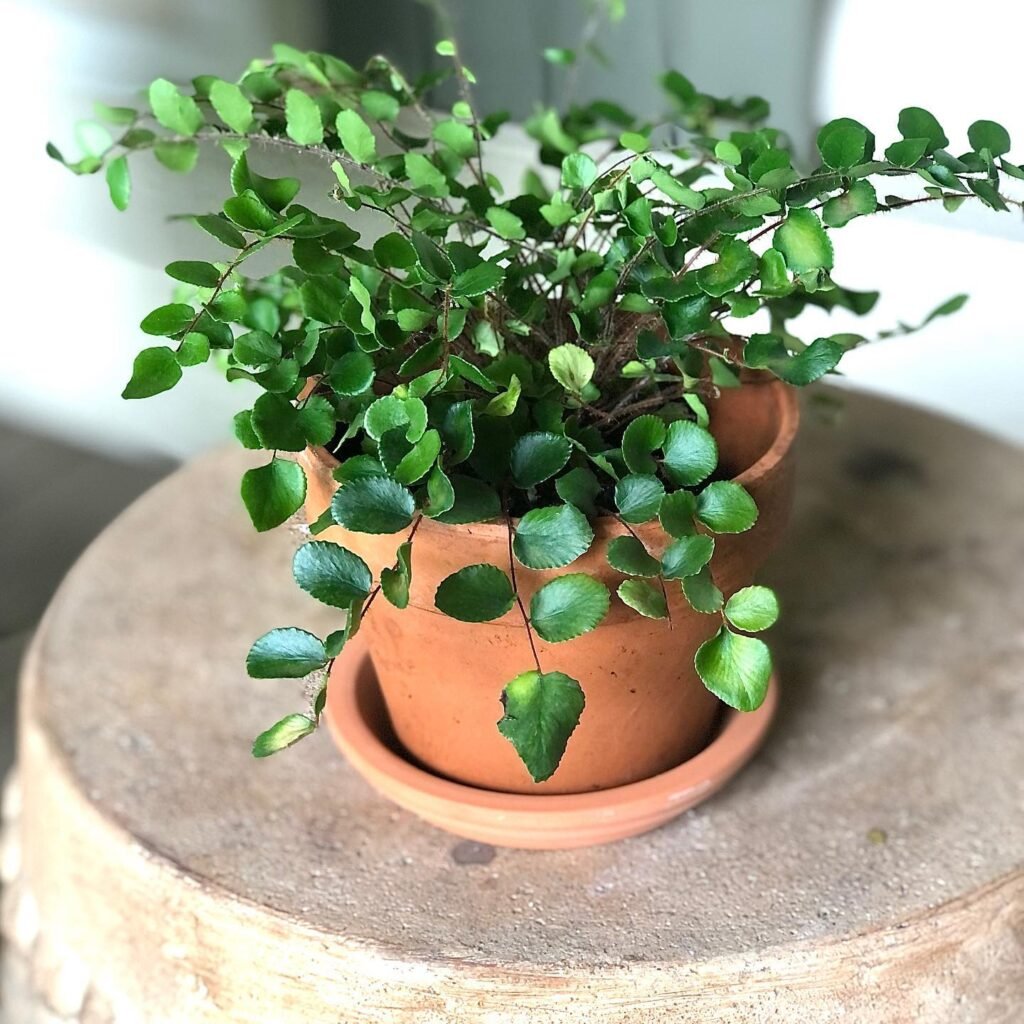
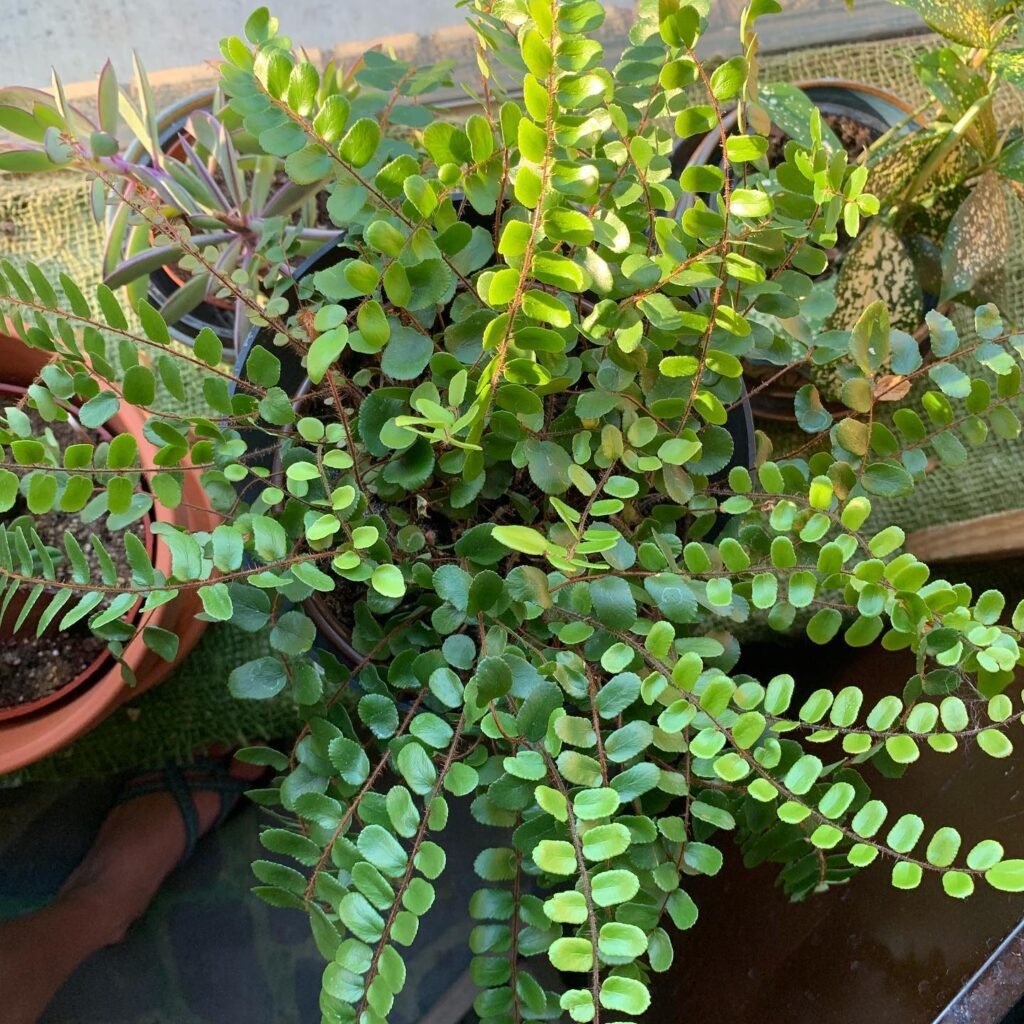
Pellaea rotundifolia, or Button Fern, thrives in bright, indirect light. It should be placed in a location that receives moderate to bright light, but it should be protected from direct sunlight, as this can scorch the fronds. In the UK, it is best to place the Button Fern near a north or east-facing window, where it can receive gentle dappled lighting.
If the fern is situated in excessively dark conditions, it may result in slowed growth and the development of soil mould. Providing the proper light conditions is crucial for the health and growth of the Button Fern.

Watering Tips for Pellaea rotundifolia (Button Fern)


When it comes to watering your Pellaea rotundifolia, or Button Fern, it’s important to strike the right balance to keep it healthy and thriving. The key is to maintain evenly moist soil, allowing the top third of the soil to dry out in between waterings.
Overwatering can lead to root rot and other moisture-related issues, while underwatering can cause the fronds to yellow and crisp.
So how do you know when it’s time to water your Button Fern? Simply check the top of the soil and water when it feels slightly dry to the touch. This will help prevent the risk of overwatering and maintain the ideal moisture level for your fern.
In addition to regular watering, misting the fronds of your Button Fern can provide a boost of humidity, which is beneficial since these ferns prefer higher humidity levels. Simply use a spray bottle to mist the fronds occasionally and recreate the natural environment they thrive in.

Fertilizing and Soil for Pellaea rotundifolia
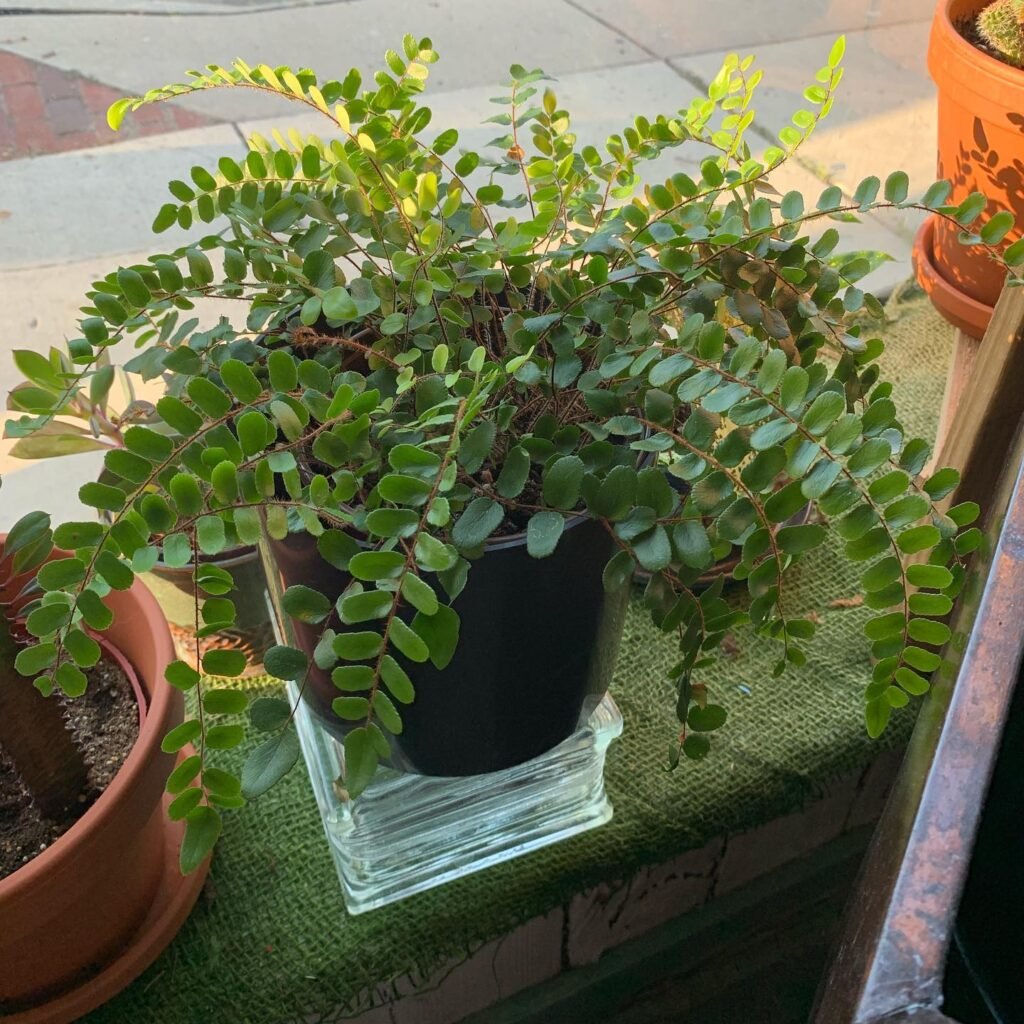

The Pellaea rotundifolia, more commonly known as the Button Fern, flourishes in soil that strikes the perfect balance between fertility and drainage. It has a preference for an acidic environment, thriving when planted in ericaceous compost, which is specially formulated for acid-loving plants.
Fertilisation plays a pivotal role in the health and growth of the Button Fern. For optimal results, I advocate for the use of a balanced houseplant fertiliser throughout the plant’s growing season. During the spring and summer months, a routine of fertilising every fourth watering ensures the Button Fern is well-supplied with the vital nutrients it needs to grow. However, as the autumn and winter months draw in, it’s advisable to dial back the frequency of fertilisation to every sixth watering.
Attending to the Button Fern’s specific soil and fertilisation needs is essential for its wellbeing. By ensuring the soil has the correct pH and providing regular, tailored fertilisation, you’re setting the stage for your Pellaea rotundifolia to showcase lush, vibrant foliage and enjoy healthy development. This careful attention to its growing conditions allows the Button Fern to truly thrive, bringing a touch of natural elegance to your indoor space.

Pruning and Maintenance for Button Fern


Pellaea rotundifolia, or Button Fern, is a low-maintenance indoor plant that typically does not require pruning. However, there are some maintenance tasks that can be beneficial for the overall health and appearance of the plant.
If you notice any yellowed or dying leaves on your Button Fern, it is recommended to remove them. This not only encourages better growth but also improves the overall aesthetic appeal of the plant. When pruning, it is important to use clean scissors or shears to minimize the risk of diseases spreading.
The Button Fern is generally resistant to pests and diseases. However, it is still crucial to conduct regular maintenance to ensure its well-being. Removing old leaves and debris helps prevent the accumulation of pests or diseases, keeping the plant in optimal condition.
To summarize, while Button Ferns don’t require extensive pruning, removing yellowed or dying leaves is beneficial for growth and appearance. Regular maintenance, involving the removal of old leaves, helps maintain the plant’s overall health. By following these simple maintenance practices, you can enjoy the beauty of your Pellaea rotundifolia ‘Button Fern‘ for years to come.

Propagating Pellaea rotundifolia (Button Fern)


Pellaea rotundifolia, also known as Button Fern, is a wonderful indoor plant that can easily be propagated to expand your collection. There are two main methods of propagation: spores and division.
Propagation through Spores
- First, locate matured brown and crispy spores on the fronds of your Button Fern.
- Gently separate the spores from the fronds and place them on top of a moist compost. Ensure that the compost is kept consistently moist.
- Create a humid environment by covering the pot with a clear plastic bag or using a propagator to maintain moisture levels.
- Provide indirect light for the spores to germinate and develop into new ferns. Avoid direct sunlight, as it can be harmful.
- With patience and proper care, the spores will germinate, and you’ll soon have new Button Ferns to enjoy!
Propagation through Division
Another effective method of propagating Pellaea rotundifolia is through division. Follow these simple steps:
- Carefully remove the Button Fern from its pot.
- Inspect the plant and identify natural divisions or sections that can be separated.
- Use a clean, sharp knife or scissors to separate the sections.
- Plant each section in an individual pot filled with well-draining soil.
- Water the newly potted sections and provide them with the same care as mature Button Ferns.
- With time, each section will grow into a separate plant, allowing you to expand your collection.
By utilizing these propagation techniques, you can easily multiply your Button Ferns and enjoy their beauty throughout your home or share them with fellow indoor plant enthusiasts. Have fun experimenting with propagation and watching your plants flourish!

Repotting Tips for Pellaea rotundifolia


As a proud owner of a beautiful Pellaea rotundifolia, or Button Fern, you’ll want to ensure it has plenty of room to grow and thrive. Repotting your Button Fern every three years is vital for its health and well-being. Here are some valuable tips for successful repotting:
- Choose the right time: The best time to repot your Button Fern is during its active growth period in spring or early summer. This allows the plant to recover and establish itself in its new container.
- Select the appropriate pot: When choosing a new pot, opt for one that is slightly larger than the current container. This will give the root system ample space to expand and grow. Ensure the pot has drainage holes to prevent waterlogging and promote a healthy root environment.
- Use a well-draining potting mix: It’s crucial to prioritize the proper soil mix for your Button Fern. A well-draining potting mix, such as an ericaceous compost, works wonders. This type of mix mimics the fern’s native environment, providing the necessary drainage it craves.
- Check for root-bound roots: Before repotting, gently remove the Button Fern from its current container and inspect the roots. If you notice any circling or root-bound roots, carefully trim them to encourage healthy growth in the new pot.
- Safely repot your Button Fern: Once you’ve prepared the new pot and removed any excessive roots, place the fern in its new home. Fill the gaps around the root ball with the potting mix and gently firm it in place. Ensure the plant is positioned at the same depth as before, with the top of the root ball level with the soil surface.
- Water and care for the repotted fern: After repotting, give your Button Fern a thorough watering to settle it into its new container. Then, continue regular care by providing the appropriate light, watering, and fertilization according to the fern’s needs.
By following these repotting tips, you’ll provide fresh nutrients and ample space for your Pellaea rotundifolia to flourish in its new home. Remember, a happy Button Fern is a beautiful addition to your indoor plant collection!
 The Button Fern is brilliant at adjusting to different humidity levels? It’s perfect for UK homes, as it doesn’t need much fuss over air moisture. This makes it a top choice for indoor gardeners, easy to care for in both dry and damp conditions. A true survivor, it’s as versatile as it is charming.
The Button Fern is brilliant at adjusting to different humidity levels? It’s perfect for UK homes, as it doesn’t need much fuss over air moisture. This makes it a top choice for indoor gardeners, easy to care for in both dry and damp conditions. A true survivor, it’s as versatile as it is charming.
Toxicity of Pellaea rotundifolia (Button Fern)
Pellaea rotundifolia, or Button Fern, is generally non-toxic to humans and pets. However, it is always recommended to keep plants out of reach of children and pets to prevent accidental ingestion. While the Button Fern is considered safe, it is best to exercise caution and avoid any potential risks.
Helpful Videos about Caring for Pellaea rotundifolia (Button Fern)
I’ve discovered some fantastic videos online that’ll help you grow a Pellaea rotundifolia (Button Fern) in your garden. These guides are filled with easy-to-understand tips to ensure your plant flourishes, covering everything from the basics to some clever little tricks. Whether you’re a novice to gardening or have been enjoying it for some time, these videos will make caring for your Pellaea rotundifolia straightforward and enjoyable.
- Care Tips For Ferns | Houseplant Tips & Tricks Ep. 14
FAQ about Caring for Your Pellaea rotundifolia (Button Fern)

Fancy making your Pellaea rotundifolia (Button Fern) the standout feature of your indoor garden? Jump into my bespoke FAQ where I reveal all you need to know for nurturing your Button Fern. From pinpointing the perfect spot for sunlight to mastering the art of watering, I’ve prepared everything to ensure your fern doesn’t just survive, it thrives.
Pellaea rotundifolia thrives in well-draining, loose, and rich soil. A mix of potting soil with some perlite and peat moss is ideal to ensure proper drainage and aeration.
Button Ferns prefer indirect, filtered light. Direct sunlight can scorch their leaves, so a spot that receives bright but indirect light is perfect.
Water your Button Fern when the top inch of the soil feels dry. They like consistent moisture but don’t do well with waterlogged soil. In the UK, this might mean watering once a week, but adjust based on your home’s humidity levels.
Feed your Button Fern with a half-strength, balanced liquid fertilizer once a month during the growing season (spring and summer). No need to fertilize in autumn and winter.
Repot in spring every couple of years or when it outgrows its pot. Use a slightly larger pot with fresh, well-draining potting mix to give it room to grow.
Pellaea rotundifolia can be grown outdoors in the UK during the warmer months. However, it should be brought indoors or protected when temperatures drop, as it’s not frost-hardy.
Brown tips can be a sign of dry air or under-watering. Increase humidity around the plant and ensure the soil is moist but not soggy. Trimming the brown tips with clean scissors can improve its appearance.
Yellow leaves could indicate over-watering, poor drainage, or a nutrient deficiency. Check the soil and adjust your watering schedule or repot if necessary.
Place a humidity tray under the plant, group it with other plants, or use a room humidifier to increase moisture in the air.
Yes, Button Ferns are non-toxic to cats and dogs, making them a safe choice for pet owners.
Button Ferns can be propagated by division during repotting. Gently separate the rhizomes and plant them in separate pots.
Leggy growth often indicates insufficient light. Move your fern to a brighter location where it will receive indirect sunlight.
Inspect your fern regularly for signs of pests like spider mites or aphids. Gently wipe the leaves with a mild soap solution or use an appropriate insecticidal soap.
A pot with good drainage holes is essential. Terra cotta or breathable pots are ideal as they allow soil to dry more evenly.
Gently dust the leaves with a soft, damp cloth. This will help the plant absorb more light and improve its overall health.
Yes, bathrooms often provide the humid conditions Button Ferns love, making them an excellent choice for this room, provided there is enough indirect light.
Yes, Pellaea rotundifolia can thrive in terrariums due to their love for humid environments. Ensure the terrarium is well-ventilated and not placed in direct sunlight.
I hope this makes caring for your Pellaea rotundifolia (Button Fern) clearer. Got more questions? Pop them in the comments, and I’ll reply. Remember, we all start from scratch, and learning about your garden is a wonderful adventure.
Conclusion
Pellaea rotundifolia, commonly known as the Button Fern, is a stunning indoor plant that thrives in the UK with proper care. With its unique appearance and easy-care nature, it is an ideal choice for plant enthusiasts looking to add a touch of greenery to their homes.
When it comes to caring for the Button Fern, providing the right conditions is essential. Place it in a location that receives bright, indirect light, away from direct sunlight to prevent frond scorching. Keep the soil moderately moist, allowing the top third to dry out between waterings.
Fertilize regularly during the growing season with a balanced houseplant fertilizer and use well-draining soil. Regular maintenance, like pruning yellowed leaves, helps keep your Button Fern healthy and attractive. Additionally, you can propagate the plant through spores or division to expand your collection.
By following these plant care tips, you can ensure the health and vitality of your Pellaea rotundifolia and enjoy its beauty for years to come. With a little attention and love, this indoor plant will bring a touch of nature’s elegance to your home.

